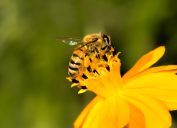If You See This Bug, You May Have to Quarantine
Over 30 counties are already under quarantine because of the spotted lanternfly. Is yours next?

In May, just when we thought the COVID-19 pandemic was all we could handle, we learned about murder hornets. And now, 2020 has thrown another creature our way to be concerned about. Enter the spotted lanternfly, a beautiful yet destructive bug that has a striped bee-like body and a set of sheer wings on top of a pair of red wings, both speckled with black spots. While the bug might sound benign enough—after all, at least "murder" isn't in its name—New Jersey and Pennsylvania have put a combined 34 counties under quarantine due to its presence. And if you live on the East Coast, your county could be next.
According to the U.S. Department of Agriculture (USDA), the spotted lanternfly is not a danger to humans, but it does wreak havoc on plant life. It can severely affect crops including almonds, stone fruits, apples, hops, and a variety of trees. And it's known to slyly transport itself via people since it can only fly short distances. So, the current quarantine put in place to prevent these insects from spreading is not implemented to protect humans directly, but our agriculture.
Currently, 26 counties in Pennsylvania are under quarantine and 8 in New Jersey: Warren, Hunterdon, Mercer, Burlington, Camden, Gloucester, Salem and Somerset.
"While the spotted lanternfly is no threat to humans or animals, it is known to feed on 70 different types of plants and trees," the New Jersey Department of Agriculture said in a statement. "The Department asks that anyone who travels in a quarantined county do a quick inspection of their vehicle for the spotted lanternfly before leaving."

The quarantine slows the spread of the spotted lanternfly, giving officials more time to get their population under control. "We have been working diligently to slow the advance of this bug," New Jersey Department of Agriculture Secretary Douglas Fisher said in a statement. "We are targeting areas where severe infestations have been confirmed, and we also encourage residents to destroy the spotted lanternfly if possible when they see it. It will take a combined effort to help keep this pest from spreading."
The spotted lanternfly is indigenous to China, but hitched a ride to the U.S. in 2014 on a shipment landing in Berks County, Pennsylvania. "The species has been advancing ever since," the New Jersey Department of Agriculture says.
RELATED: For more up-to-date information, sign up for our daily newsletter.
Surefire signs the spotted lanternfly has touched down in your garden is "plants that ooze or weep and have a fermented odor," a "buildup of sticky fluid (honeydew) on plants and on the ground underneath infested plants," or "sooty mold on infested plants," according to the USDA. If you see any of these signs, you should contact your local Extension office or State Plant Regulatory Official. For more concerning creatures that could be in your yard, check out 17 Disturbing Health Dangers Lurking in Your Backyard.





















